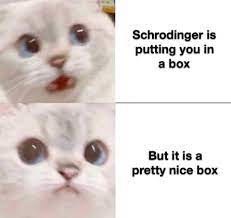Schrödinger's Cat

“Curiosity kills the cat.”
Have you ever wondered how curiosity can actually kill a cat? Yes, it’s none other than one of the most famous thought experiments “Schrödinger’s Cat” devised by physicist Erwin Schrödinger to illustrate quantum mechanics.
This thought experiment presents a hypothetical cat being placed into a closed box containing a radioactive substance with equal probability of decaying, and a flask containing poisonous gas. If radioactivity is detected(ie. the atoms have decayed), a hammer is released that breaks the flask and poisonous gas is released, killing the cat.
As there are equal probability of atoms decaying, no one can say that the cat is either dead or alive until one opens the box. Thus, the cat is said to be simultaneously dead and alive, which is a state known as Quantum Superposition. Yet if one opens the box, one sees that the cat is either dead or alive, not both dead and alive.
This thought experiment greatly illustrate the interpretations of quantum mechanics, as one can say that a subatomic event can simultaneously occus and not occur until one observes it.
Curiosity makes us open the box,
but it may also kill the cat!
Keywords
-
Erwin Schrödinger: Erwin Rudolf Josef Alexander Schrödinger (12 August 1887 – 4 January 1961), sometimes written as Erwin Schrodinger or Erwin Schroedinger, was a Nobel Prize-winning Austrian-Irish physicist who developed a number of fundamental results in quantum theory. In popular culture, he is most known for his “Schrödinger’s cat” thought experiment.
-
Quantum Superposition: Quantum superposition is a fundamental principle of quantum mechanics. It states that, much like waves in classical physics, any two (or more) quantum states can be added together (“superposed”) and the result will be another valid quantum state; and conversely, that every quantum state can be represented as a sum of two or more other distinct states.
-
Decay: Radioactive decay is the process by which an unstable atomic nucleus loses energy by radiation. A material containing unstable nuclei is considered radioactive.
-
Quantum Mechanics: Quantum mechanics is a fundamental theory in physics that provides a description of the physical properties of nature at the scale of atoms and subatomic particles. It is the foundation of all quantum physics including quantum chemistry, quantum field theory, quantum technology, and quantum information science.
Images


References
https://en.wikipedia.org/wiki/Erwin_Schrödinger
https://en.wikipedia.org/wiki/Quantum_superposition
https://en.wikipedia.org/wiki/Schrödinger%27s_cat
https://www.youtube.com/watch?v=UjaAxUO6-Uw
https://en.wikipedia.org/wiki/Radioactive_decay
https://en.wikipedia.org/wiki/Quantum_mechanics